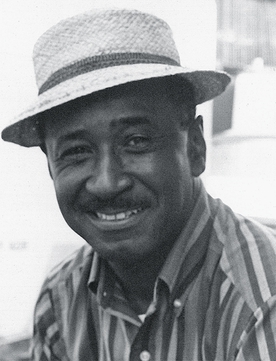Albert Murray (writer) facts for kids
Quick facts for kids
Albert Murray
|
|
|---|---|
 |
|
| Born | May 12, 1916 Nokomis, Escambia County, Alabama, U.S.
|
| Died | August 18, 2013 (aged 97) Harlem, New York, U.S.
|
Albert L. Murray (May 12, 1916 – August 18, 2013) was an American writer. He was known for his work as a literary and music critic, a novelist, an essayist, and a biographer. Some of his famous books include The Omni-Americans, South to a Very Old Place, and Stomping the Blues.
Contents
About Albert Murray
His Early Life
Albert Murray was born in Nokomis, Alabama. His birth mother, Sudie Graham, gave him up for adoption. He was adopted by Hugh and Mattie Murray. Albert grew up in the Magazine Point area of Mobile, Alabama.
He earned a scholarship to Tuskegee Institute. In 1939, he received a degree in education. One of his classmates there was Ralph Ellison. Ralph Ellison later became a famous writer. He wrote the novel Invisible Man in 1952.
After Tuskegee, Murray briefly studied at the University of Michigan. He returned to Tuskegee in 1940 to teach literature and writing. In 1941, he married Mozelle Menefee. They had a daughter named Michele. He also continued his studies at Northwestern University and the University of Paris.
Serving His Country
In 1943, Murray joined the United States Army Air Forces. He served in the military for several years. In 1946, he joined the United States Air Force Reserve. He then studied at New York University using the GI Bill. He earned a master's degree in English in 1948. During this time, he met the famous musician Duke Ellington. He also became very close friends with Ralph Ellison.
Murray returned to Tuskegee briefly. Then, in 1951, he joined the Active Guard Reserve. This helped him support his young family better. For the next ten years, Murray was stationed in many places. These included Morocco, California, and Massachusetts. He also taught a course on world politics at Tuskegee. In 1962, he retired from the United States Air Force as a major. He and his wife moved to Harlem, New York. They lived there for the rest of their lives.
A Career in Writing
After retiring from the Air Force, Murray began his writing career. He wrote regularly for magazines like Life and The New Leader. In 1964, his article "The Problem Is Not Just Black and White" was published in Life. It looked at seven books about race relations.
Books and Ideas
Murray published his first book, The Omni-Americans, in 1970. It was a collection of essays and reviews. These essays discussed topics like protest literature. In the book's introduction, he wrote that the United States is "a nation of multi-colored people." Author Walker Percy called it "the most important book on black-white relations."
His next book was South to a Very Old Place (1971). This non-fiction book was about the American South. It started as a reporting job for Harper's Magazine. The famous writer Toni Morrison reviewed it in The New York Times. It was also a finalist for the National Book Award.
Starting in 1974, Murray wrote four novels. These books featured a character named Scooter. Scooter was like a version of Murray himself. The novels followed Scooter from his childhood through college. They also showed his career as a musician and writer.
Music and Friendships
Albert Murray also wrote about the importance of blues and jazz music. His books on this topic include The Hero and the Blues (1973) and Stomping the Blues (1976). He won an award for Stomping the Blues. He also worked with the jazz legend Count Basie. They wrote Basie's life story, Good Morning Blues (1985).
Murray taught at many universities. These included Columbia University, Colgate University, and Emory University. He also received honorary degrees from Colgate and Spring Hill College.
As mentioned, he became very good friends with Ralph Ellison after college. Their friendship influenced both of their writing. Their letters were published in a book called Trading Twelves in 2000. Murray was also friends with the artist Romare Bearden. Bearden's famous artwork The Block (1971) was inspired by the view from Murray's apartment in Harlem.
Murray became more widely known in the 1980s and 1990s. This was because of his influence on critic Stanley Crouch and jazz musician Wynton Marsalis. Murray and Marsalis were co-founders of Jazz at Lincoln Center. This is a famous jazz organization.
In 1996, writer Henry Louis Gates Jr. wrote about Murray in New Yorker magazine. He said, "This is Albert Murray's century; we just live in it." In 1998, Murray received the first Harper Lee Award.
His Later Years
Albert Murray passed away in Harlem on August 18, 2013. The next month, a special memorial service was held for him. It took place at Jazz at Lincoln Center.
In 2016, a collection of his non-fiction writing was released. It was published by the Library of America. Another collection of his fiction and poetry came out in 2018.

